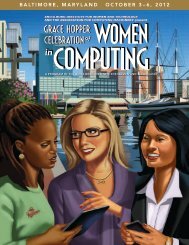ABI-ONE ghc program v14.indd - Grace Hopper Celebration of ...
ABI-ONE ghc program v14.indd - Grace Hopper Celebration of ...
ABI-ONE ghc program v14.indd - Grace Hopper Celebration of ...
You also want an ePaper? Increase the reach of your titles
YUMPU automatically turns print PDFs into web optimized ePapers that Google loves.
10:45-11:45 am<br />
PhD Forum 3 –<br />
UI/Education<br />
Location: Regency Ballroom VII<br />
Mentor: Andrea Danyluk (Williams<br />
College)<br />
Usable Security in Practice:<br />
Collaborative Management <strong>of</strong><br />
Electronic & Physical Personal<br />
Information<br />
Presenter: Laurian C. Vega (Virginia<br />
Polytechnic Institute)<br />
need exists in HCI to study how issues<br />
A <strong>of</strong> trust and privacy can and do affect<br />
the ad hoc negotiation <strong>of</strong> security rules and<br />
how they are managed in actual practice.<br />
For my dissertation I present data from pilot<br />
interviews and observations to examine the<br />
physical and electronic security practices <strong>of</strong><br />
childcares and medical <strong>of</strong>fices. I propose to<br />
study the policy breakdowns that affect the<br />
security <strong>of</strong> personal information.<br />
In the Beginning: The Early Lives <strong>of</strong><br />
Users in Online Communities<br />
Presenter: Katherine Panciera (University<br />
<strong>of</strong> Minnesota)<br />
The most crucial part <strong>of</strong> a user’s life is the<br />
time between when they first view a<br />
system and twenty-four hours after their first<br />
participation in that system. From that point<br />
on, odds are that their participation will<br />
decline. When designing online communities,<br />
we need to understand this more<br />
deeply. My research also proposes a mixed<br />
methods study <strong>of</strong> early life user behavior in<br />
Cyclopath, a geowiki for bicyclists.<br />
p r O G r a m d e Ta i L<br />
WEDNESDAY | SEPT 29<br />
Building Pr<strong>of</strong>essional Identity<br />
as Computer Science Teachers:<br />
Supporting Secondary Computer<br />
Science Teachers through Reflection<br />
and Community Building<br />
Presenter: Lijun Ni (Georgia Institute <strong>of</strong><br />
Technology)<br />
Currently, we are facing big challenges<br />
<strong>of</strong> preparing and supporting K-12 CS<br />
teachers. In addition to increasing the<br />
number <strong>of</strong> CS teachers, there is a great<br />
need <strong>of</strong> supporting those teachers to grow<br />
and retain as committed, quality teachers.<br />
This thesis work focuses on exploring ways<br />
<strong>of</strong> supporting CS teachers through understanding<br />
their teacher identity and exploring<br />
ways <strong>of</strong> supporting identity development<br />
through a pr<strong>of</strong>essional development <strong>program</strong><br />
for CS teachers.<br />
PhD Forum 4 –<br />
Networks/Machine<br />
Translation<br />
Location: Hanover CDE<br />
Mentor: Elizabeth Mynatt (Georgia<br />
Institute <strong>of</strong> Technology)<br />
Word Alignment with Parallel Phrases<br />
Presenter: Maria Holmqvist (Linköping<br />
University)<br />
present a method for word alignment<br />
I that uses parallel phrases from manually<br />
word aligned sentence pairs to align words<br />
in new texts. Experiments on an English-<br />
Swedish parallel corpus showed that the<br />
phrase-based method produced word alignments<br />
with high precision. Phrase-based<br />
alignment was compared to statistical word<br />
alignment and it was found that a combination<br />
<strong>of</strong> phrase-based and statistical word<br />
alignments outperformed pure statistical<br />
alignment in terms <strong>of</strong> Alignment Error<br />
Rate (AER).<br />
Modeling and Testing <strong>of</strong> Service-<br />
Oriented Applications<br />
Presenter: Ewa Musial (University at<br />
Albany, State University <strong>of</strong> New York)<br />
In this paper we present a technique<br />
testing not only services but also their<br />
interactions with execution context. The<br />
technique utilizes a dependence model that<br />
depicts relationships between services,<br />
external resources, and other application<br />
components. Based on this model, we first<br />
associate the specifications with the model<br />
to cover the requirements. Then we use<br />
node and dependence edge coverage criteria<br />
to create additional test cases to achieve<br />
adequate testing.<br />
Assuring Network Service with<br />
Bandwidth and Integrity Based<br />
Fairness<br />
Presenter: Fariba Khan (University <strong>of</strong><br />
Illinois at Urbana-Champaign)<br />
DDoS attackers take control <strong>of</strong> large<br />
bandwidth and services that otherwise<br />
would have been lightly used by genuine<br />
users. IBQ and ASV take the power<br />
back from them by taking two different<br />
approaches. In ASV clients use otherwise<br />
underutilized bandwidth. ASV can be implemented,<br />
without the cooperation <strong>of</strong> the core<br />
routers, by slight modification <strong>of</strong> the client<br />
and server applications. IBQ introduces a<br />
tiered integrity system and prioritizes high<br />
integrity packets.<br />
Anita Borg Institute for Women and Technology | <strong>Grace</strong> <strong>Hopper</strong> <strong>Celebration</strong> <strong>of</strong> Women in Computing 19




